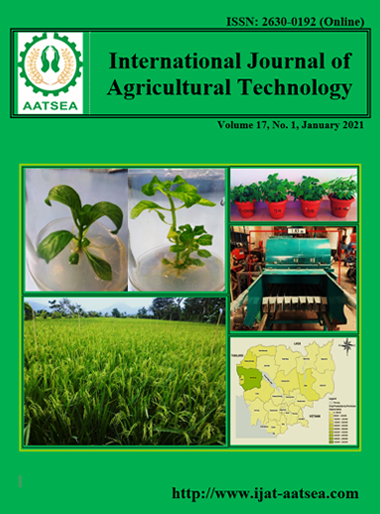Determination of supplementary irrigation water requirement and schedule for Sorghum in Kobo-Girana Valley, Ethiopia
Main Article Content
Abstract
Rain-fed is the main season agriculture shares the largest crop production system in Amhara region. However, due to erratic nature of rainfall, crop production is always at a risk. For this reason, crop production in the arid and semi-arid regions of Ethiopia including Kobo-Girana Valley usually requires supplemental irrigation. Supplemental irrigation is the application of a limited amount of water to the crop when rainfall fails to provide sufficient water for plant growth to increase and stabilize yields. There was a significant difference among treatments in stalk biomass, grain yield and water productivity. As observed data in the experimental years, the grain yield widely ranged from 5.397t ha-1 to 1.53t ha-1. Complementing of the crop at optimal depth of application (100%) and optimal time of application starting from development stage gave the highest stalk biomass of 11t ha-1 and grain yield 5.397 t ha-1. It had a maximum yield advantage of 2.874 t ha-1 compared with the controlled system in 2011 cropping season. In the second year (2012) complemented the optimal generated depth (100%) at optimal time of application starting from development stage, seasonal irrigation water of 330.6 mm which had a yield advantage of 1.607 t ha-1 compared with supplementing of the optimum depth of application (100%) at mid-stage in 8 days irrigation interval. Finally supplementing of irrigation water starting from development stage to mid stage at 8 days interval was vital for sorghum production in Kobo-Girana valley area
Article Details

This work is licensed under a Creative Commons Attribution-NonCommercial-NoDerivatives 4.0 International License.
References
Adnan, A., Ahmed, H., Theib, O. and Mustafa, P. (2002). Wheat productivity under supplemental irrigation in northern Iraq. On-Farm water husbandry research report reries, No.2. International Center for Agricultural Research in the Dry Areas (ICARDA), Aleppo, Syria, vi+38 pp.
Agnew, C. and Chappell, A., (1999). Drought in the Sahel. GeoJournal, 48:299-311.
Ali, M. A., Niaz, S., Abbas, A., Sabir, W. and Jabran, K. (2009). Genetic diversity and assessment of drought tolerant sorghum landraces based on borph-physiological traits at different growth stages. Plant Omics Journal, 2:214- 227.
Athavale, R. N. (1986). Hydrological basis of a strategy for scheduling supplementary irrigation to cereal crops in dry-land agriculture. http://oar.icrisat.org/4265/1/CP_299.pdf
Bacha, D., Namara, R., Bogale, A. and Tesfaye, A. (2011). Impact of small-scale irrigation on household poverty: empirical evidence from the Ambo district in Ethiopia. Irrigation and Drainage, 60:1-10.
Barron, J., Rockström, J., Gichuki, F. and Hatibu, N. (2003). Dry spell analysis and maize yields for two semi-arid locations in east Africa. Agricultural and Forest Meteorology, 117:23-37.
Bewket, W. and Conway, D. (2007). A note on the temporal and spatial variability of rainfall in the drought-prone Amhara region of Ethiopia. International Journal of Climatology, 27:1467-1477.
Central Statistics Agency for Ethiopia (2012). Crop production. Retrieved from http://www.csa.gov.et/survey-report/category/129-eth-agss-2012#
Ethiopian Institute of Agricultural Research (EIAR) (2014). Ethiopian Strategy for Sorghum (2014-2024). Retrieved from (https://www.kstate.edu/smil/docs/country_resources/ Ethiopian%20Strategy%20for%20Sorghum.pdf.)
FAOSTAT (2015). Retrieved from http://Faostat.fao.org.
Food and Agricultural organization (2005). Retrieved from http://faostat. fao.org/site/408/ default.aspx.
Kinfe, H. (2018). Yield performance and adoption of released sorghum varieties in Ethiopia. Edelweiss Applied Science and Technology, 2:46-55.
Mekbib, F. (2008). Farmers’ breeding of sorghum in the center of diversity, Ethiopia: I. socioecotype differentiation, varietal mixture and selection efficiency. Journal of New Seeds, 9:43-67.
Meze-Hausken (2004). Contrasting climate variability and meteorological drought with perceived drought and climate change in northern Ethiopia. Climate Research, 27:19-31.
Ministry of Agriculture (2010). Ethiopia’s Agricultural Sector Policy and Investment Framework (PIF) 2010-2020. Retrieved from http://extwprlegs1.fao.org/docs/pdf/eth149550.pdf.
Oweis, T. and Hachum, A. (2012). Supplemental irrigation: A highly efficient water-use practice. ICARDA, Aleppo, Syria.iv + 28 pp.
Oweis, T., Hachum, A. and Kijne, J. (1999). Water harvesting and supplemental irrigation for improved water use efficiency in dry areas. SWIM Paper No. 7, System-Wide Initiative on Water Management. International Water Management Institute (IWMI), Colombo, Sri Lanka.
Rockström, J., Nuhu, H., Theib, O. and Suhas, P. W. (2007). Managing Water in Rain-fed Agriculture. Pages 315-348 in Water for Food, Water for Life: A Comprehensive Assessment of Water Management in Agriculture (ed. David Molden). London, UK: Earthscan and Colombo, Srilanka: International Water Management Institute.
Segele, Z. T. and Lamb, P. J. (2005). Characterization and variability of Kiremt rainy season over Ethiopia. Meteorology and Atmospheric Physics, 89:153-180.
Theib, O. and Ahmed, H. (2003). Improving water productivity in the dry areas of West Asia and North Africa. Pages 179-198 in Water Productivity in Agriculture: Limits and Opportunities for Improvement (Kijne, W. J. Barker, R. and Molden, D. eds) CABI Publishing, Wallingford, UK.
Tilahun, K. (1999). Test of homogeneity, frequency analysis of rainfall data and estimate of drought probabilities in Dire Dawa, Eastern Ethiopia. Ethiopian Journal of Natural Resources, 1:125-136.
Vavilov, N. I. (1951). The Origin, variation, Immunity and Breeding of cultivated plants. The Ronald press Co., New York, NY.
Wale, A., Sebnie, W., Girmay, G. and Beza, G. (2019). Evaluation of the potentials of supplementary irrigation for improvement of sorghum yield in WagHimra, north eastern, Amhara, Ethiopia. Cogent Food & Agriculture, 5:1664203.
Wani, S. P. (2008). A New Paradigm for Rainfed Agriculture for Improving Livelihoods and Sustainable Development in India. 2008. Proceedings of the National Workshop on New Paradigm for Rainfed Farming held at New Delhi during 27-29 Sept 2007, pp.30-31.


